Equity and Inclusion in Climate Action and Adaptation Plans of Michigan Cities
Abstract
1. Introduction
- How have Michigan cities addressed equity in their climate plans across various sectors and what groups of stakeholders have been included in the planning process?
- How could the Two-Eyed Seeing approach being reflected in TCAM strategies help cities to improve their planning efforts?
- To evaluate and compare consideration of equity in the climate action and adaptation plans of Michigan cities.
- To evaluate and compare the inclusion of various groups of stakeholders engaged in the development of existing and forthcoming climate action and adaptation plans in Michigan.
- To evaluate how the TCAM framework could inform and improve cities’ climate adaptation planning strategies.
2. Methodology
2.1. Selection of Climate Action and Adaptation Plans
2.2. Assessment Framework for Equity and Diversity of Stakeholders
2.3. Interviews and Survey
3. Results and Discussion
4. Conclusions
- Develop and enforce state and national guidelines that include DEI standards to ensure uniformity while allowing for adaptations to local conditions.
- Improve the capability of local governments to manage and implement climate strategies through comprehensive training and resources.
- Promote regional fora for cities, such as the Midwest Climate Resilience Conference and the Great Lakes Adaptation Forum, to share best practices and lessons learned, as well as promote a collaborative atmosphere that expedites the adoption of effective climate solutions.
- Establish formal collaboration frameworks between cities and tribal governments to ensure climate strategies are respectful and integrative of traditional ecological knowledge.
- Develop participatory planning processes, similar to C4 in Grand Rapids, MI, that actively involve all community members, especially underrepresented groups, to ensure that diverse perspectives are considered in climate planning.
- Shift focus from planning to execution, with robust mechanisms to monitor and evaluate the impact of climate strategies, allowing for continuous feedback and improvement.
Author Contributions
Funding
Institutional Review Board Statement
Informed Consent Statement
Data Availability Statement
Acknowledgments
Conflicts of Interest
References
- ICLEI Local Governments for Sustainability. Changing Climate Changing Communities: Guide and Workbook for Municipal Change Adaptation; ICLEI-Canada: Toronto, ON, Canada, 2019. [Google Scholar]
- Araos, M.; Berrang-Ford, L.; Ford, J.D.; Austin, S.E.; Biesbroek, R.; Lesnikowski, A. Climate adaptation planning in large cities: A systematic global assessment. Environ. Sci. Policy 2016, 66, 375–382. [Google Scholar] [CrossRef]
- Wheeler, S.M. State and municipal climate change plans: The first generation. J. Am. Plan. Assoc. 2008, 74, 481–496. [Google Scholar] [CrossRef]
- U.S. EPA. 2024–2027 Climate Adaptation Plan; U.S. EPA: Washington, DC, USA, 2024.
- Crimmins, A.R.; Avery, C.W.; Easterling, D.R.; Kunkel, D.E.; Stewart, B.C.; Maycock, T.K. 2023: Fifth National Climate Assessment; USGCRP: Washington, DC, USA, 2023.
- U.S. Government. Presidential Documents, Executive Order 14008 of January 27, 2021; Federal Register; U.S. Government: Washington, DC, USA, 2021; Volume 86, pp. 7619–7633.
- Georgetown Climate Center. Adaptation Clearinghouse. Available online: https://www.adaptationclearinghouse.org/ (accessed on 27 October 2021).
- Sharifi, A. Trade-offs and conflicts between urban climate change mitigation and adaptation measures: A literature review. J. Clean. Prod. 2020, 276, 122813. [Google Scholar] [CrossRef]
- Chi, C.-F.; Lu, S.-Y.; Hallgren, W.; Ware, D.; Tomlison, R. Role of Spatial Analysis in Avoiding Climate Change Maladaptation: A Systematic Review. Sustainability 2021, 13, 3450. [Google Scholar] [CrossRef]
- ADEME—Agence de la Transition Écologique. Observatoire Territoires et Climat. 2022. Available online: https://www.territoires-climat.ademe.fr/observatoire (accessed on 5 May 2024).
- National Institute for Environmental Studies. A-Plat: Climate Change Adaptation Information Platform. 2024. Available online: https://adaptation-platform.nies.go.jp/en/index.html (accessed on 30 May 2024).
- Bierbaum, R.; Smith, J.; Lee, A.; Blair, M.; Carter, L.; Chapin, F.; Fleming, P.; Ruffo, S.; Stults, M.; McNeeley, S.; et al. A comprehensive review of climate adaptation in the United States: More than before, but less than needed. Mitig. Adapt. Strateg. Glob. Change 2013, 18, 361–406. [Google Scholar] [CrossRef]
- Herrick, C.; Vogel, J. Climate Adaptation at the Local Scale: Using Federal Climate Adaptation Policy Regimes to Enhance Climate Services. Sustainability 2022, 14, 8132. [Google Scholar] [CrossRef]
- Caggiano, H.; Kocakuşak, D.; Kumar, P.; Tier, M.O. U.S. cities’ integration and evaluation of equity considerations into climate action plans. NPJ Urban Sustain. 2023, 3, 50. [Google Scholar] [CrossRef]
- Woodruff, S.C.; Stults, M. Numerous strategies but limited implementation guidance in US local adaptation plans. Nat. Clim. Change 2016, 6, 796. [Google Scholar] [CrossRef]
- Lioubimtseva, E. The role of inclusion in climate vulnerability assessment and equitable adaptation goals in small American municipalities. Discov. Sustain. 2022, 3, 3. [Google Scholar] [CrossRef]
- Michigan Department of Environment, Great Lakes, and Energy (EGLE). MI Healthy Climate Plan. 2022. Available online: https://www.michigan.gov/egle/about/organization/climate-and-energy/mi-healthy-climate-plan (accessed on 7 May 2024).
- Michigan Legislature. Bills. 2023. Available online: https://legislature.mi.gov/Bills/ (accessed on 1 May 2024).
- Michigan Climate Action Council. Michigan Climate Action Plan. 2009. Available online: https://uccrnna.org/wp-content/uploads/2017/06/Michigan_2009_Climate-Action-Plan.pdf (accessed on 7 May 2024).
- US EPA. Summary of Inflation Reduction Act Provisions Related to Renewable Energy. 25 October 2023. Available online: https://www.epa.gov/green-power-markets/summary-inflation-reduction-act-provisions-related-renewable-energy (accessed on 13 March 2024).
- Chu, E.K.; Cannon, C.E. Equity, inclusion, and justice as criteria for decision-making on climate adaptation in cities. Curr. Opin. Environ. Sustain. 2021, 51, 85–94. [Google Scholar] [CrossRef]
- AECF. The Annie E. Casey Foundation. 16 October 2021. Available online: https://www.aecf.org/blog/racial-justice-definitions?gclid=CjwKCAjw8KmLBhB8EiwAQbqNoHL0r04pzkQfSOyPGFt0r5_J3Ksk1JgEG84EQFCvCEiFp6CC4Qvm-BoCBA0QAvD_BwE (accessed on 7 May 2024).
- Reckien, D.; Lwasa, S.; Satterthwaite, D.; McEvoy, D.; Creutzig, F. Equity, Environmental Justice, and Urban Climate Change. In Climate Change and Cities: Second Assessment Report of the Urban Climate Change Research Network; Cambridge University Press: New York, NY, USA, 2018; pp. 173–224. [Google Scholar]
- Roberson, Q.M. Disentangling the Meanings of Diversity and Inclusion; Center for Advanced Human Resource Studies/Cornell University Working Paper Series; Cornell University: Ithaca, NY, USA, 2004; Volume CAHRS WP 04–05, pp. 2–31. [Google Scholar]
- Inter-Tribal Council of Michigan. Adapt: Collaborative Tribal Climate Adaptation Planning. 2016. Available online: https://www.itcmi.org/wp-content/uploads/2022/04/Climate-Adaptation-Planning-Booklet.pdf (accessed on 10 April 2024).
- Tribal Adaptation Menu Team. Dibaginjigaadeg Anishinaabe Ezhitwaad: A Tribal Climate Adaptation Menu; Great Lakes Indian Fish and Wildlife Commission: Odanah, WI, USA, 2019. [Google Scholar]
- McMillan, T. Anishinaabe Values and Servant Leadership: A Two-Eyed Seeing Approach. J. Values-Based Leadersh. 2022, 16, 11. [Google Scholar] [CrossRef]
- State of Michigan. State of Michigan. 2024. Available online: https://www.michigan.gov/ (accessed on 10 August 2024).
- U.S. Census. Michigan. 2022. Available online: https://data.census.gov/profile/Michigan?g=040XX00US26 (accessed on 5 May 2024).
- Townsend, S.; Kirk, B.; Powers, M. City of Traverse City Climate Action Plan; SEEDS Inc.: Traverse City, MI, USA, 2011. [Google Scholar]
- White, L.E.A. Climate Adaptation in the Great Lakes Region A Case Study of Traverse City, Michigan; University of Michigan School of Natural Resources and Environment: Ann Arbor, MI, USA, 2015. [Google Scholar]
- City of Grand Rapids. Climate Action and Adaptation Plan. 2024. Available online: https://www.grandrapidsmi.gov/Government/Departments/Sustainability/Climate-Change/Climate-Action-and-Adaptation-Plan (accessed on 12 May 2024).
- Lioubimtseva, E.; Da Cunha, C. Local climate change adaptation plans in the US and France: Comparison and lessons learned in 2007–2017. Urban Clim. 2020, 31, 100577. [Google Scholar] [CrossRef]
- Aboagye, P.D.; Sharifi, A. Urban climate adaptation and mitigation action plans: A critical review. Renew. Sustain. Energy Rev. 2024, 189, 113886. [Google Scholar] [CrossRef]
- Northridge, M.; Freeman, L. Urban planning and health equity. J. Urban Health 2011, 88, 582–597. [Google Scholar] [CrossRef] [PubMed]
- Lioubimtseva, E.; da Cunha, C. Community Engagement and Equity in Climate Adaptation Planning: Experience of Small- and Mid-Sized Cities in the United States and in France. In Justice in Climate Action Planning; Strategies for Sustainability; Petersen, B., Ducros, H.B., Eds.; Springer: Cham, Switzerland, 2022; pp. 257–276. [Google Scholar]
- Lioubimtseva, E.; da Cunha, C. The Role of Non-Climate Data in Equitable Climate Adaptation Planning: Lessons from Small French and American Cities. Sustainability 2023, 15, 1556. [Google Scholar] [CrossRef]
- City of Ann Arbor Office of Sustainability and Innovations. A2ZERO Action Plan 4.0; City of Ann Arbor: Ann Arbor, MI, USA, 2020. [Google Scholar]
- PopulationU. PopulationU.com. 2024. Available online: https://www.populationu.com/cities/ann-arbor-mi-population (accessed on 2 April 2024).
- U.S. Census Bureau. QuickFacts: Ann Arbor City, Michigan. 2022. Available online: https://www.census.gov/quickfacts/fact/table/annarborcitymichigan/PST045223 (accessed on 2 April 2024).
- Detroiters Working for Environmental Justice. Detroit Climate Action Plan; DetroitEnvironmentalJustice.org: Detroit, MI, USA, 2017; Available online: https://detroitenvironmentaljustice.org/wp-content/uploads/2017/11/CAP_WEB.pdf (accessed on 5 January 2023).
- U.S. Census Bureau. QuickFacts: Detroit City, Michigan; United States. 2022. Available online: https://www.census.gov/quickfacts/fact/table/detroitcitymichigan/PST045223 (accessed on 2 April 2024).
- U.S. Census. QuickFacts: Traverse City City, Michigan. 2022. Available online: https://www.census.gov/quickfacts/fact/table/traversecitycitymichigan/PST045223 (accessed on 3 April 2024).
- Inter-Tribal Council of Michigan, Inc. Member Tribes. 2021. Available online: https://www.itcmi.org/home/tribes/ (accessed on 25 June 2024).
- Sangha, K.; Gordon, I.J.; Constanza, R. Ecosystem Services and Human Wellbeing-Based Approaches Can Help Transform Our Economies. Front. Ecol. Evol. 2022, 13, 841215. [Google Scholar] [CrossRef]
- Match-E-Be-Nash-She-Wish Band of Pottawatomi Indians. Climate Change Adaptation Plan; Match-E-Be-Nash-She-Wish Band of Pottawatomi Indians, Gun Lake Tribe: Shelbyville, MI, USA, 2015.
- Keweenaw Bay Indian Community. Keweenaw Bay Indian Community Hazards Mitigation Plan; Keweenaw Bay Indian Community: Baraga, MI, USA, 2021. [Google Scholar]
- Grand Traverse Band of Ottawaand Chippewa Indians. Grand Traverse Band of Ottawaand Chippewa Indians Natural Hazard Mitigation Plans; Grand Traverse Band of Ottawaand Chippewa Indians: Suttons Bay, MI, USA, 2023. [Google Scholar]
- Menzies, A.K.; Bowles, E.; Gallant, M.; Patterson, H.; Kozmik, C.; Chiblow, S. “I see my culture starting to disappear”: Anishinaabe perspectives on the socioecological impacts of climate change and future research needs. Facets 2022, 7, 509–527. [Google Scholar] [CrossRef]
- Cottrell, C. From assembly to action: How planning language guides execution in indigenous climate adaptation. Mitig. Adapt. Strateg. Clim. Change 2023, 28, 24. [Google Scholar] [CrossRef] [PubMed]
- Martinez, D.J.; Meadow, A.M.; Manning, B.R.M.; Maldonado, J. Climate Justice and Climate Adaptation in California: Indigenous Community Climate Adaptation Leadership and Opportunities for Scientific Collaboration. Weather Clim. Soc. 2024, 16, 339–404. [Google Scholar] [CrossRef]
- Anguelovski, I.; Shi, L.; Chu, E.; Gallagher, D.; Goh, K.; Lamb, Z.; Reeve, K.; Teicher, H. Equity Impacts of Urban Land Use Planning for Climate Adaptation: Critical Perspectives from the Global North and South. J. Plan. Educ. Res. 2016, 36, 333–348. [Google Scholar] [CrossRef]
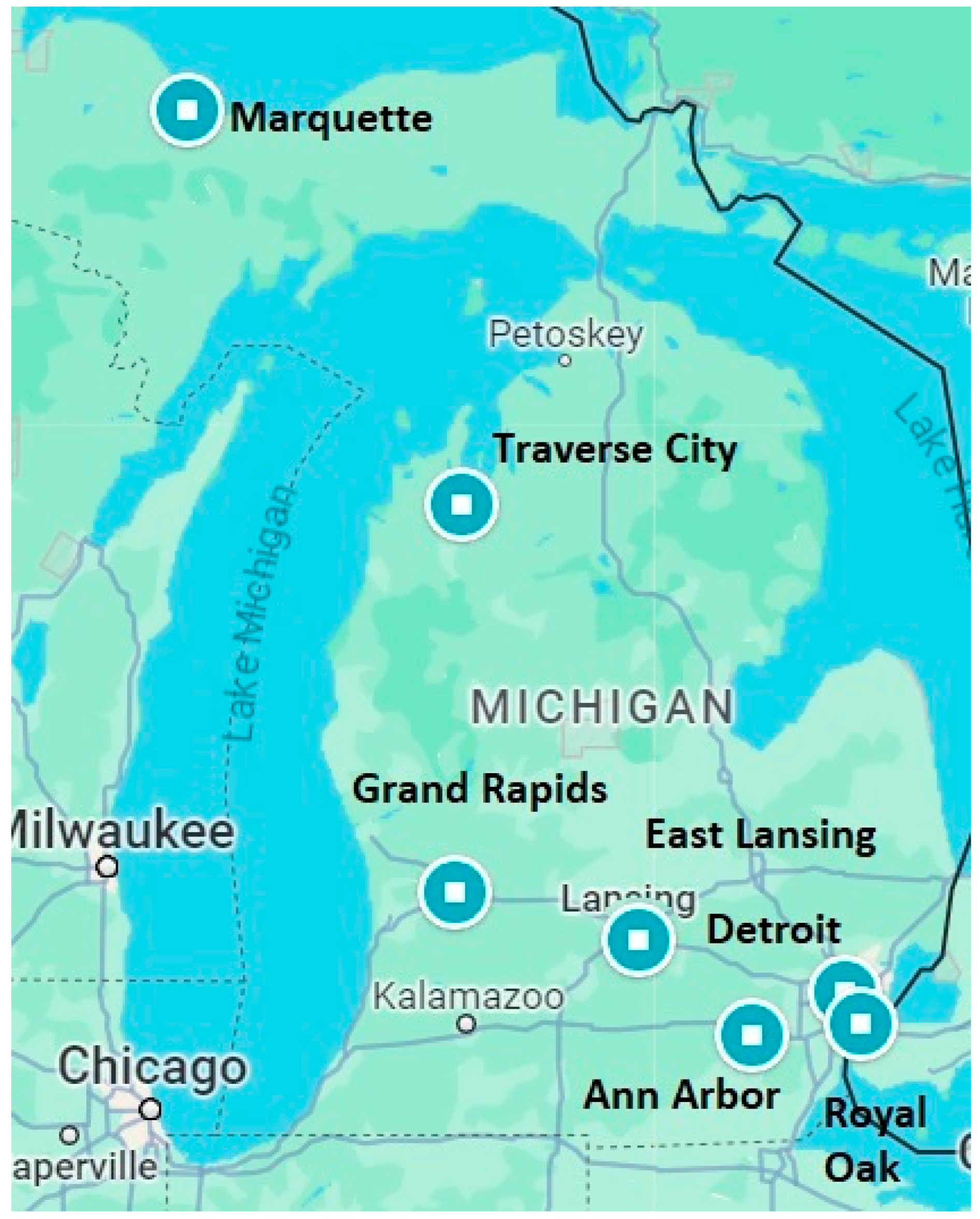
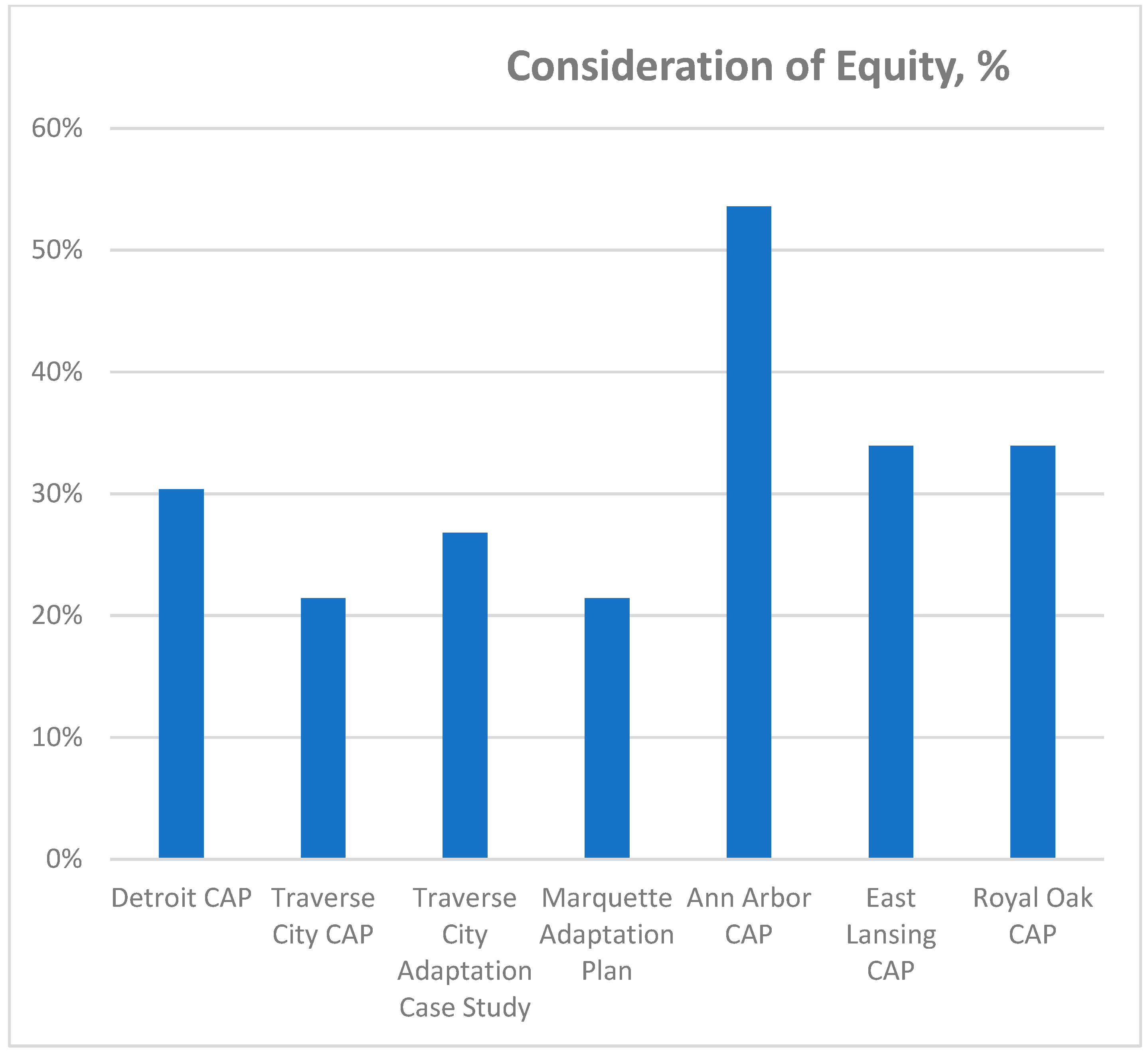
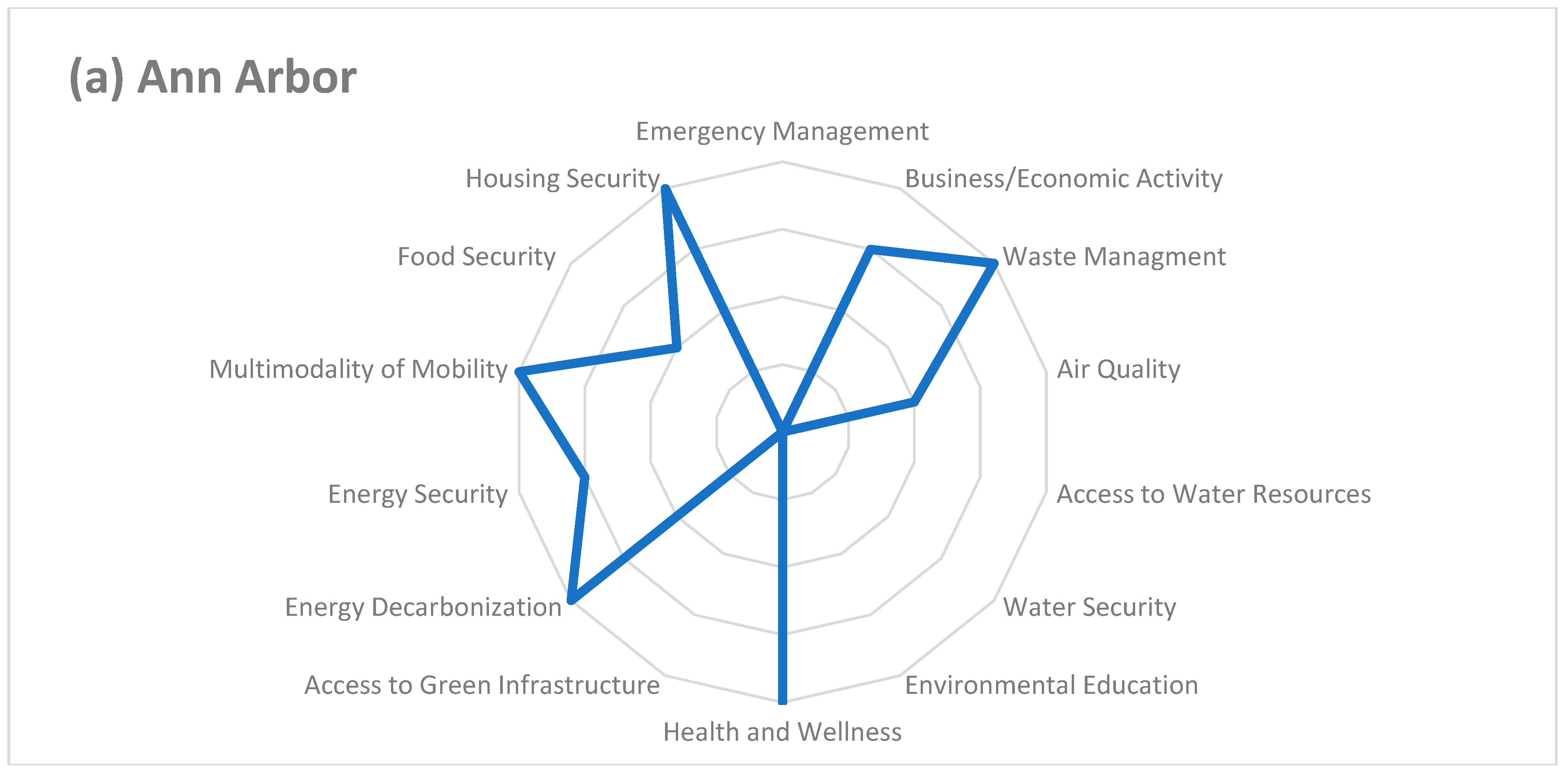
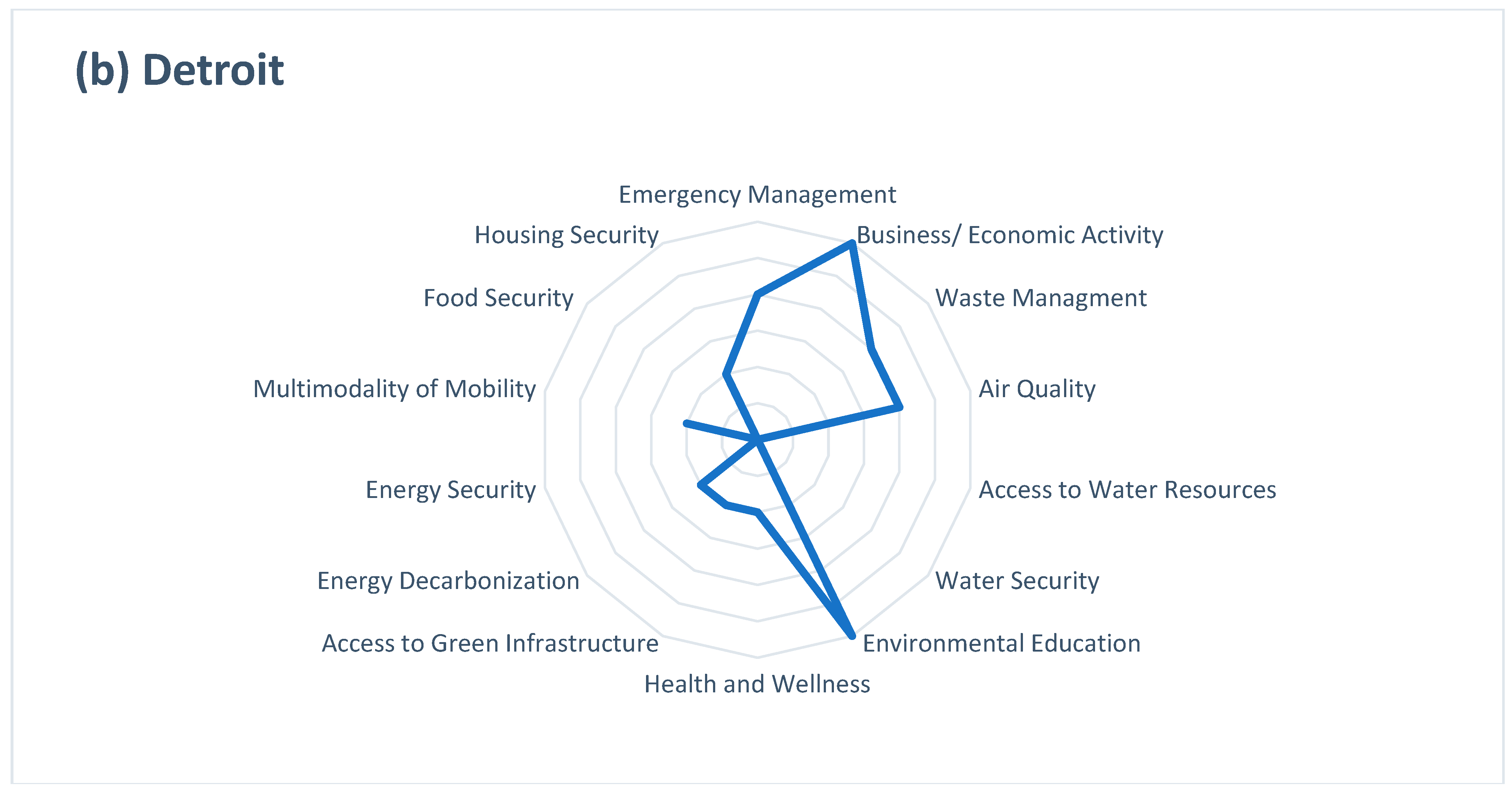
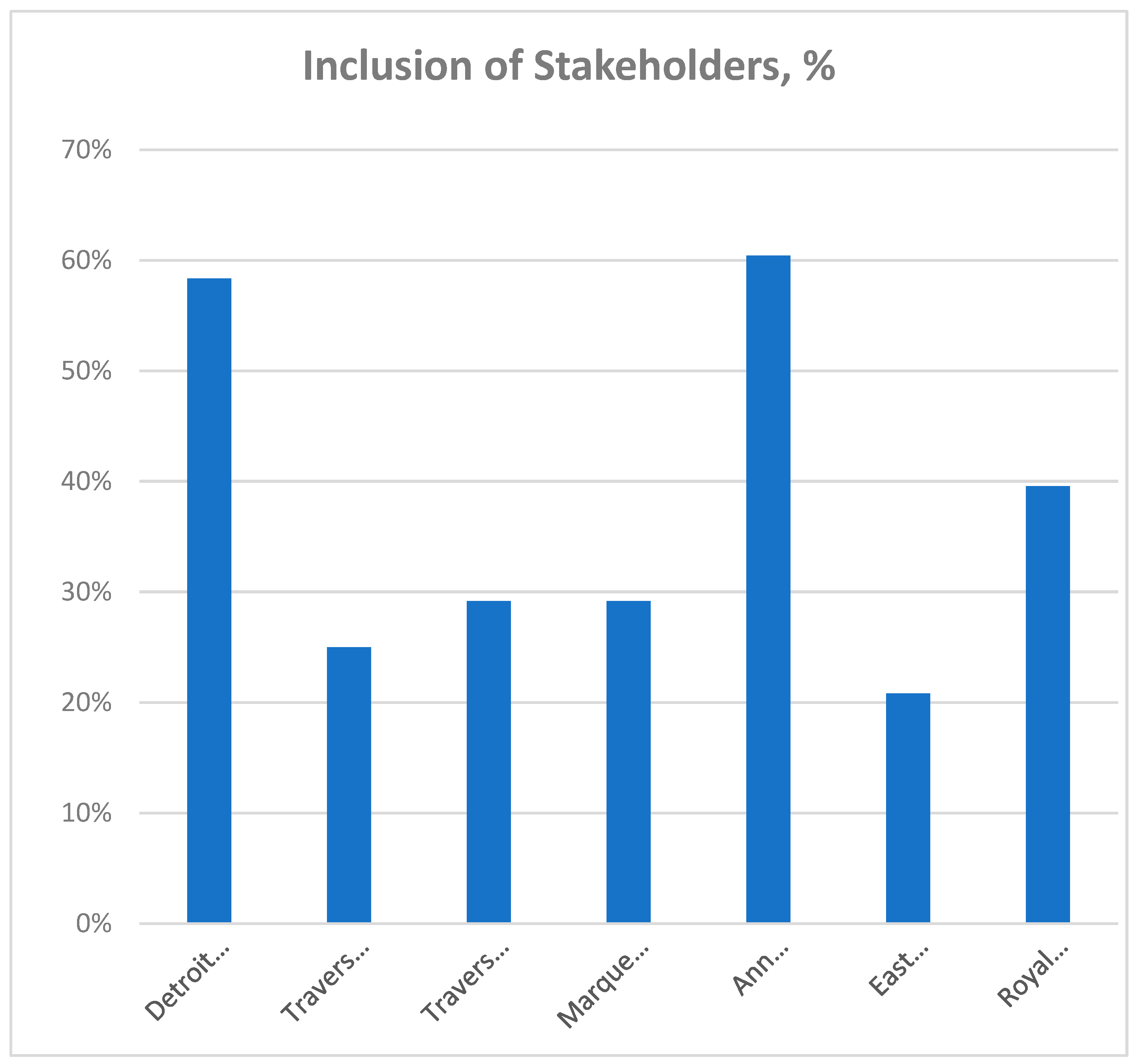
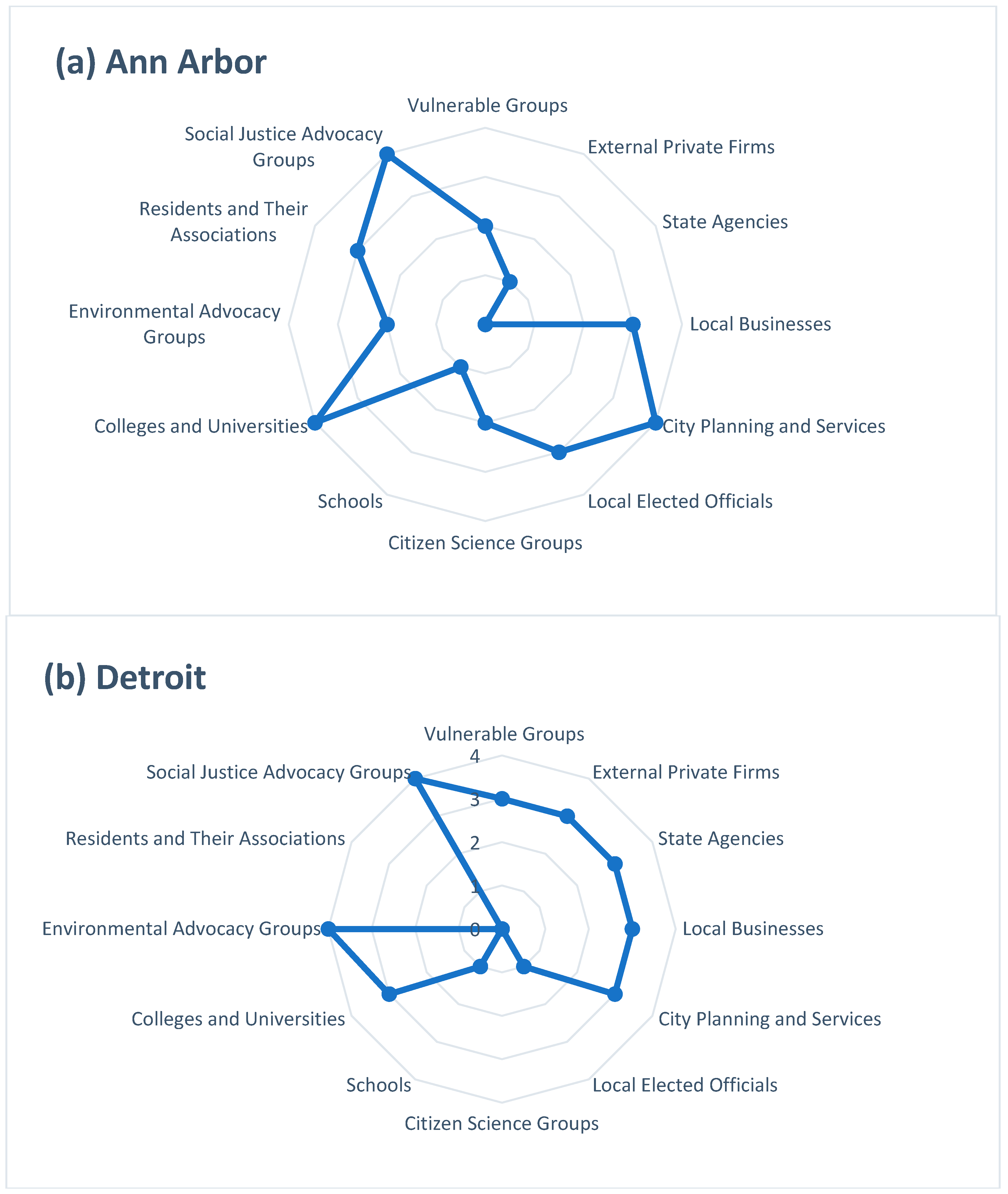
| City | Title | Goals | Year |
|---|---|---|---|
| Ann Arbor | A2Zero: Ann Arbor Living Carbon Neutrality Plan | Mitigation with elements of adaptation | 2020 |
| Detroit | Detroit Climate Action Plan: Detroiters Working for Environmental Justice | Mitigation with elements of adaptation | 2017 |
| East Lansing | Climate Sustainability Plan: Meeting our Climate Action and Green Community Goals | Mitigation with elements of adaptation | 2012 |
| Grand Rapids | Climate Action and Adaptation Plan | Mitigation and adaptation | 2024 (expected) |
| Marquette | Adapting to Climate Change and Variability | Adaptation | 2013 |
| Royal Oak | Royal Oak Sustainability and Climate Action Plan | Mitigation and adaptation | 2022 |
| Traverse City | City of Traverse City Climate Action Plan | Mitigation | 2011 |
| Climate Adaptation in the Great Lakes Region: A Case Study of Traverse City, Michigan | Adaptation | 2015 |
| # | Consideration of Climate Equity in Each Adaptation Planning Domain | Diversity and Inclusion of Stakeholders |
|---|---|---|
| 0 | Planning domain is absent | None |
| 1 | Planning domain is present in general, but does not address equity measures | Participant (attended community meetings, participated in surveys or interviews, recognized in the plan) |
| 2 | Planning domain is present, and equity is mentioned as a value or aspirational goal but strategies for achieving equity are not explained | Content co-creator (contributed specific data and information, referenced in the plan) |
| 3 | Planning domain is present and strategies for achieving equity are explained | Collaborator (engaged in decision-making, acknowledged in the plan) |
| 4 | Planning domain is present and strategies for achieving equity are explained. Evaluation plan is provided. | Author/Co-author (listed on a cover page) |
| Participant | Equity Consideration | Collaboration Across Sectors | Inclusion of Stakeholders | Funding Sources | Specific Actions or Goals |
|---|---|---|---|---|---|
| 1 | Equity and adaptation recently integrated more deeply. Formation of a community-steering committee shows a community-driven approach. | Focus on connecting housing to mobility and development of warming/cooling centers. Community-driven efforts highlighted. | Local officials and community groups’ involvement emphasizes community-driven implementation. | Public and private funding with a focus on aligning with DEI goals. Highlights funding strategy aimed at equity. | Decarbonization and transportation improvements with community input. Reflects targeted action towards sustainability and equity. |
| 2 | Creation of equity frameworks for advisory teams to ensure decision-making includes equity. Partnership with C4 for diverse community voices. | Advisory teams with mixed expertise and resident experience for transportation planning. Emphasizes structured collaboration. | C4 ensures inclusion of diverse voices in planning. Reflects a partnership model for inclusivity. | Grants from foundations for projects indicate targeted funding approach. Partnership with C4 for specific community projects. | Sustainability and equity are key in the citywide strategic plan, indicating an integrated approach to planning. |
| 3 | Focus on initiatives like the ‘0’ program for energy efficiency in low-income areas. Proactive community engagement for BIPOC inclusion. | BIPOC community engagement for input into planning through surveys and sessions. Specific efforts to engage underrepresented communities. | Efforts to include BIPOC communities through targeted engagement strategies. Focus on accessible participation. | Mentions possible federal funds without specifics. Indicates a need for exploring diverse funding sources. | Energy efficiency pilot projects in focus neighborhoods. Demonstrates actionable steps towards equity in climate action. |
| 4 | Each action in the climate plan has an equity section, emphasizing a systematic integration of equity across the board. | Wide range of stakeholders involved, including housing commissions, CBOs, and universities, illustrating an inclusive collaboration approach. | Rethought engagement for inclusivity with tactical models and targeted outreach. Engagement positions outside traditional settings. | Climate tax and philanthropic funding for community partners. Innovative funding approaches for community-based initiatives. | Actions include energy, circular economy, and comprehensive engagement. Highlights a holistic approach to climate action. |
| 5 | Prioritizations of equitable climate solutions by engaging with financially constrained communities, ensuring climate actions benefit those who need it the most. | Involvement in multi-city pilot programs, particularly in the area of waste management and sustainability. They also work with labor unions and housing commissions. | Advocating for union participation in green installations and fostering community engagement. Various stakeholders, including those from labor, housing, and marginalized communities, have a voice in climate action planning and implementation. | Utilized philanthropic funds for climate advocacy and has adapted to incorporate various public funding sources. Strategic use of county rebates and city mileages, which provided significant financial resources for Ann Arbor’s sustainability office and their climate action efforts. | Actions include advocating for the development of affordable green housing projects, contributing to public policy for sustainable city planning, and engaging in community projects such as the establishment of resilience hubs and tree-planting campaigns to mitigate the heat island effect and enhance urban green spaces. |
Disclaimer/Publisher’s Note: The statements, opinions and data contained in all publications are solely those of the individual author(s) and contributor(s) and not of MDPI and/or the editor(s). MDPI and/or the editor(s) disclaim responsibility for any injury to people or property resulting from any ideas, methods, instructions or products referred to in the content. |
© 2024 by the authors. Licensee MDPI, Basel, Switzerland. This article is an open access article distributed under the terms and conditions of the Creative Commons Attribution (CC BY) license (https://creativecommons.org/licenses/by/4.0/).
Share and Cite
Lioubimtseva, E.; Zylman, H.; Carron, K.; Poynter, K.; Rashrash, B.M.-E. Equity and Inclusion in Climate Action and Adaptation Plans of Michigan Cities. Sustainability 2024, 16, 7745. https://doi.org/10.3390/su16177745
Lioubimtseva E, Zylman H, Carron K, Poynter K, Rashrash BM-E. Equity and Inclusion in Climate Action and Adaptation Plans of Michigan Cities. Sustainability. 2024; 16(17):7745. https://doi.org/10.3390/su16177745
Chicago/Turabian StyleLioubimtseva, Elena, Hannah Zylman, Katherine Carron, Kaytlin Poynter, and Bushra Mohamed-Elmabruk Rashrash. 2024. "Equity and Inclusion in Climate Action and Adaptation Plans of Michigan Cities" Sustainability 16, no. 17: 7745. https://doi.org/10.3390/su16177745
APA StyleLioubimtseva, E., Zylman, H., Carron, K., Poynter, K., & Rashrash, B. M.-E. (2024). Equity and Inclusion in Climate Action and Adaptation Plans of Michigan Cities. Sustainability, 16(17), 7745. https://doi.org/10.3390/su16177745







